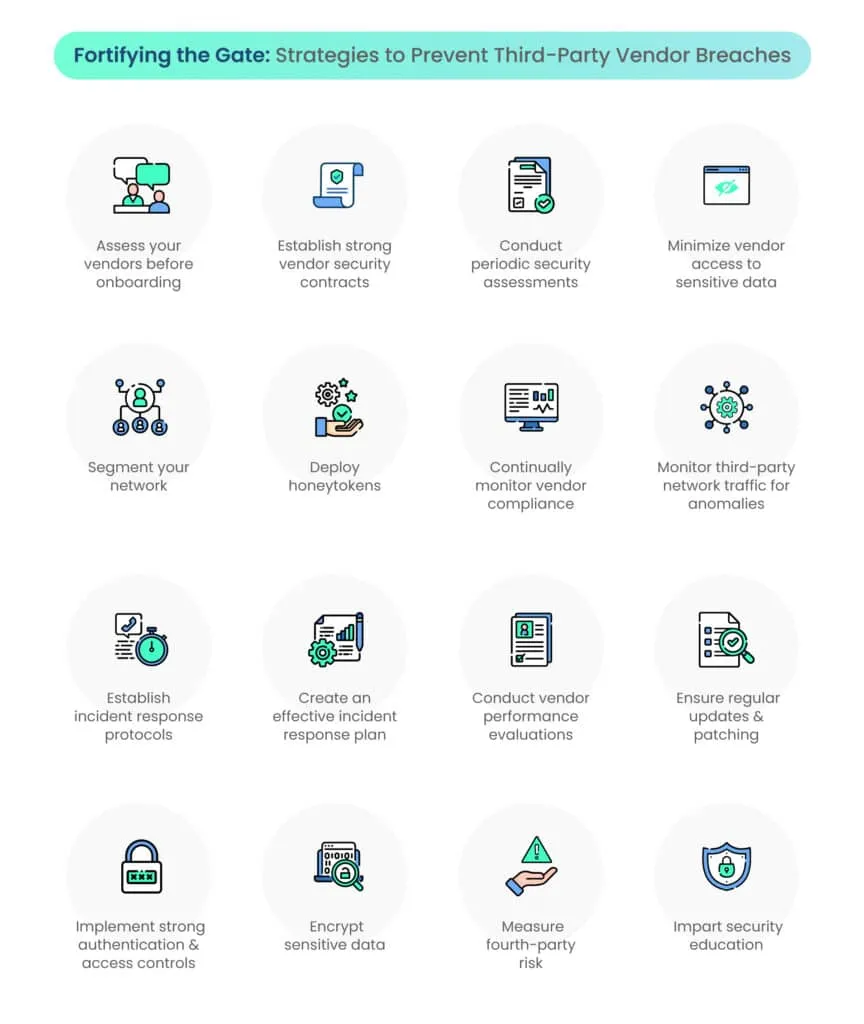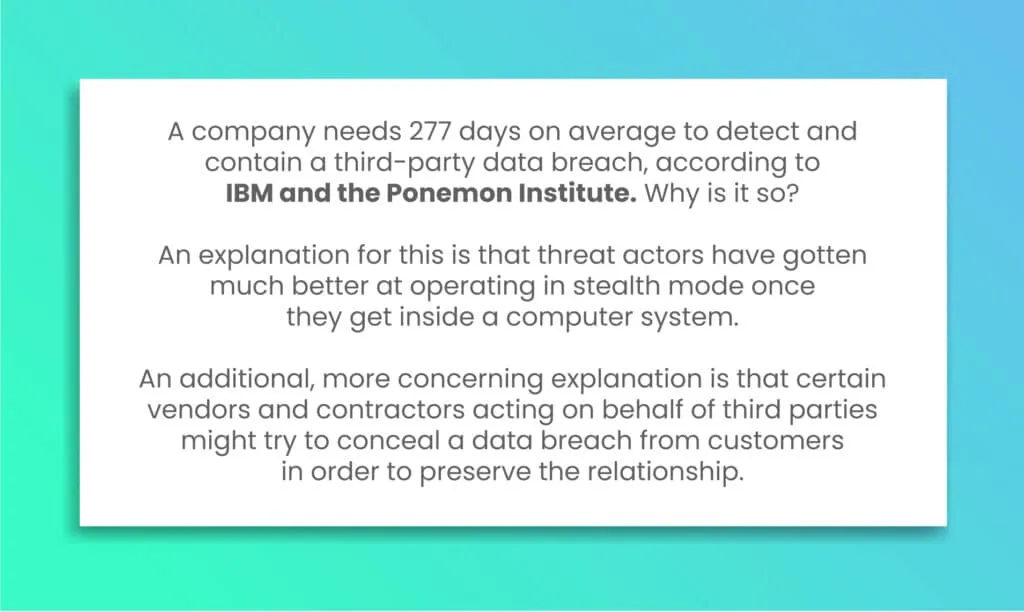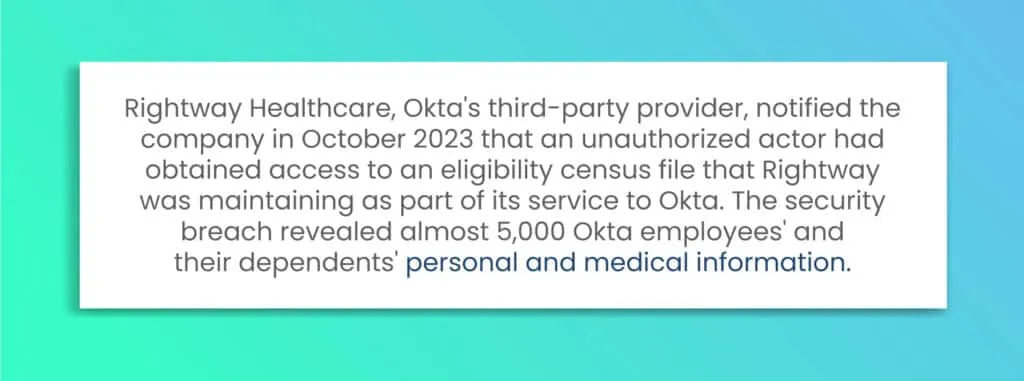Defending your data: How to safeguard against third-party vendor breaches

In today's interconnected business terrain, organizations often rely on third-party vendors to provide various services, from cloud computing and software solutions to supply chain management and customer support.
While these partnerships can bring many benefits, they also introduce significant security risks. A third-party vendor breach can have devastating consequences, ranging from data theft and financial losses to damage to an organization's reputation.
In the United States, the average cost of a data breach was projected to be $9.48 million in 2023. To safeguard sensitive data and maintain business continuity, organizations must implement a comprehensive strategy for preventing third-party vendor breaches.
This blog explores the crucial steps and best practices that organizations can employ to mitigate these risks and ensure the security of their operations.
What are third-party vendor breaches?
Third-party breaches occur when unauthorized parties gain access to confidential data from a vendor, partner, or subsidiary. This can happen through the exploitation of their systems, allowing attackers to infiltrate and steal sensitive information stored within your own systems.
Essentially, these incidents involve the compromise of external entities with trusted relationships with your organization, leading to the unauthorized access and extraction of valuable data.
Such breaches highlight the interconnected nature of cybersecurity, emphasizing the need for robust measures not only within your own infrastructure but also in collaboration with external parties to ensure comprehensive data protection.
How to prevent third-party vendor breaches

As per the Verizon 2022 Data Breach Investigations Report, third-party vendors are involved in 62% of all data breaches.
It can be challenging to hold third-party vendors responsible, particularly if you lack a third-party security policy or program. Any third-party vendor ought to adhere to the same stringent guidelines and internal data security measures that your business does.
So how do organizations best prevent third-party vendor data breaches? Here are some tried-and-tested practices to help.
1. Assess your vendors before onboarding
Due diligence is the foundation of any effective vendor security strategy. It involves a comprehensive review of a vendor's security practices, policies, and track record.
During due diligence, it's essential to identify potential risks and vulnerabilities that may exist in the vendor's systems and operations. This process often includes a thorough background check, examination of security certifications, security ratings, risk assessment, and an evaluation of the vendor's commitment to data protection and privacy.
The goal is to ensure that the vendor aligns with your organization's security standards and regulatory requirements.
In the last 12 months, 55% of security professionals said their organization had experienced an incident or breach involving the supply chain or third-party providers, according to research from independent analyst firm Forrester.
a. Conduct risk assessments
Risk assessments are a crucial part of assessing vendor security. They help organizations identify potential weaknesses and vulnerabilities within the vendor's processes and technologies.
By evaluating the risks associated with a vendor relationship, you can prioritize security measures and allocate resources accordingly. This includes identifying the most critical assets that may be at risk, such as sensitive customer data, intellectual property, or financial information.

Additionally, risk assessments enable organizations to evaluate the potential impact of a vendor breach on their operations and data.
b. Perform vendor security audits
Vendor security audits involve a detailed examination of a vendor's security controls and practices.
This process often includes a review of policies, procedures, and technology solutions in place to protect data and systems. It may also involve penetration testing and vulnerability assessments to identify weaknesses that could be exploited by cybercriminals.
Security audits provide organizations with a comprehensive understanding of the vendor's security posture and any gaps that need to be addressed.
c. Examine vendor security certifications and compliance
One way to gauge a vendor's commitment to security is by examining their certifications and compliance with industry standards and regulations.
Many organizations require vendors to adhere to specific security frameworks, such as ISO 27001 or SOC 2. Compliance with these standards demonstrates a vendor's dedication to security best practices.
When assessing vendor security, it's important to verify that the vendor complies with the relevant industry regulations and standards that apply to your organization.
2. Establish strong vendor security contracts
Once you've assessed a vendor's security practices and identified potential risks, the next crucial step is to establish robust vendor security contracts. These contracts serve as the foundation for defining security expectations and responsibilities between your organization and the vendors.
By formalizing security measures within the contract, you can help ensure that both parties are aligned in their commitment to protecting sensitive data and preventing breaches.
a. Define security requirements
The first key aspect of a strong vendor security contract is to define your organization's specific security requirements. This includes detailing the security measures, protocols, and standards that the vendor must adhere to while handling your data or providing services.
Organizations that hold vendors accountable for their security obligations through robust contracts and compliance checks were better positioned to minimize the risk and impact of breaches. Be explicit about what is expected in terms of data encryption, access controls, regular security assessments, and compliance with industry-specific regulations.
By clearly outlining your security requirements, you leave no room for ambiguity, making it easier to hold the vendor accountable for meeting these expectations.
b. Establish data protection measures
Data protection is at the heart of vendor security. In your contract, you should specify the measures that the vendor must take to protect your sensitive data. This may include encryption, data retention policies, and access control mechanisms.
Additionally, consider addressing third-party data breach notification requirements, which should be swift and comprehensive. Ensuring that the vendor has a plan in place for responding to and notifying your organization in the event of a breach is essential for minimizing the impact of a security incident.

c. Set breach notification protocols
Vendor security contracts should include explicit breach notification protocols. This outlines how the vendor will report security incidents, the timeline for doing so, and the information that should be provided.
Timely breach notification is crucial for your organization to respond effectively and minimize the consequences of a breach. Make sure these protocols align with your organization's incident response plan to ensure a coordinated response.
d. Address liability clauses and legal aspects
Contracts should address liability in the event of a security breach. Understand the legal implications and responsibilities that both parties may have in the event of a breach. Liability clauses can help protect your organization from financial losses resulting from a vendor's negligence or security lapses.
e. Ensure vendor compliance with security standards and regulations
To ensure vendor accountability, stipulate in the contract that the vendor must comply with relevant security standards and industry-specific regulations. This may include HIPAA for healthcare data, GDPR for European data, or other sector-specific requirements.
Compliance with such standards is not only legally mandated but also ensures that the vendor is following industry best practices.
3. Conduct periodic security assessments
To ensure that a vendor maintains the agreed-upon security standards, conduct periodic security assessments. Regular assessments can help identify any security weaknesses or lapses that may have emerged over time. These assessments may include vulnerability scans, penetration tests, and security audits.
Vulnerability scans systematically examine systems for potential weaknesses or vulnerabilities, while penetration tests involve simulated attacks to gauge the effectiveness of existing security measures. Security audits provide a comprehensive review of security policies, procedures, and controls.
4. Minimize vendor access to sensitive data
If a compromised vendor does not directly possess sensitive customer data, like credit card numbers, social security numbers, or phone numbers, the possible harm to your company will be lessened.
A policy implementing Privileged Access Management (PAM) will guarantee that each vendor has the minimal amount of access to sensitive resources necessary to carry out their contractual obligations.
Think about making an investment in a reliable role-based access control system that complies with the Principle of Least Privilege (POLP), which states that users, accounts, and computing processes should only have access rights necessary to complete the task at hand.
5. Segment your network
Network segmentation divides a private network to protect sensitive resources from unauthorized access. Without segmentation, adversaries can easily move laterally within a flat network architecture.
In a segmented network, direct access to sensitive resources is prevented, minimizing business impact even in the event of a breach through a compromised third party. However, to enhance security, it's crucial to combine network segmentation with access management controls.
Given the high success rates of phishing attacks, network segmentation should be a standard cybersecurity practice for businesses, including small enterprises.
An advisory from the FBI, CISA, and DOE strongly advises critical infrastructure organizations to implement network segmentation as a defense against cyberattacks sponsored by the Russian state, highlighting the efficacy of network segmentation in mitigating various forms of vendor data breaches.
6. Deploy honeytokens
Decoy systems, or honeypots, are intentionally placed to entice potential attackers and deflect their focus from the real targets. Usually, they are employed as a security measure to identify, stop, or investigate an attacker's attempt to enter a network without authorization.
Honeytokens enhance network segmentation by adding an extra layer of obfuscation. These fake sensitive resources divert cybercriminals from genuine assets.
When integrated with network segmentation, a strategically placed honeypot can redirect cybercriminals away from actual sensitive resources, facilitating the isolation of a targeted area. This enables security teams to initiate a cybersecurity incident response plan.
7. Continually monitor vendor compliance
Monitoring vendor compliance with security standards and contractual agreements is essential. Create a structured process for assessing how well the vendor is adhering to the security requirements and obligations outlined in the contract. Regularly review reports, logs, and security-related documents provided by the vendor to validate their compliance.
8. Monitor third-party network traffic for anomalies
Monitoring third-party network traffic for anomalies is a crucial aspect of preventing security breaches. By implementing robust network monitoring tools, organizations can actively track the data exchanges between their systems and those of third-party vendors.
Anomalies in network traffic, such as unusual patterns, unexpected data flows, or irregular spikes in activity, may indicate potential security threats or unauthorized access. Proactively identifying these anomalies allows for swift intervention, enabling organizations to investigate and address potential issues before they escalate into serious security breaches.
Regularly analyzing third-party network traffic for anomalies is not only about detecting potential threats but also about establishing a baseline of normal behavior. Understanding the typical patterns of data exchange helps organizations differentiate between regular activities and suspicious events.
Continuous monitoring allows for the creation of effective anomaly detection algorithms, enhancing the overall security posture by providing early warning signs of potential security incidents related to third-party interactions.
This proactive approach is instrumental in maintaining a vigilant and responsive cybersecurity strategy, minimizing the risk of breaches originating from third-party vendors.

9. Establish incident response protocols
No organization is completely immune to security breaches, and even with the most rigorous security measures, there's always a possibility of third-party vendor breaches occurring. Therefore, it's crucial to be well-prepared to respond effectively when a security incident involving a third-party vendor does happen.
Establish clear incident response protocols and procedures that both your organization and the vendor should follow in the event of a security incident. This ensures a swift and coordinated response to mitigate the impact of any breach.
10. Create an effective incident response plan
In the aftermath of a breach, organizations that responded swiftly and effectively were able to minimize the damage. Having a well-defined incident response plan that includes clear roles and responsibilities is critical for such success.
One of the foundational elements of incident response readiness is the development of a comprehensive incident response plan. This plan outlines the procedures to follow in the event of a security breach.
a. Roles and responsibilities: Establishing clear roles and responsibilities for both your organization and the vendor in the incident response plan is crucial. This ensures that everyone knows their role in managing and mitigating the breach, from incident coordinators and technical experts to legal advisors and public relations representatives. A well-structured plan minimizes confusion and streamlines the response effort.
b. Communication protocols: Effective communication is paramount during a security incident. The incident response plan should specify how information will be shared between your organization and the vendor, as well as with relevant stakeholders, regulatory bodies, and the public. Timely and accurate communication helps maintain trust and transparency during a breach.
c. Containment and mitigation strategies: The incident response plan should also include strategies for containing the breach and mitigating its impact. This may involve isolating affected systems, patching vulnerabilities, and preventing further unauthorized access. Having predefined containment and mitigation procedures in place can significantly reduce the duration and severity of a breach.
d. Incident response plan testing and updates: An incident response plan is only effective if it's regularly tested and updated. Conduct simulated breach exercises, also known as tabletop exercises, to ensure that the plan works in practice. Based on the results and lessons learned from these exercises, make necessary updates to the plan to improve its effectiveness.
11. Conduct vendor performance evaluations
Apart from security considerations, evaluate the overall performance of your vendors. Assess whether they meet your service-level agreements (SLAs) and provide value to your organization. If a vendor consistently falls short of expectations, it may be time to reconsider the partnership.
12. Ensure regular updates and patching
Staying current with vendor software updates and promptly applying patches is crucial. These updates often include fixes for security vulnerabilities, so keeping systems up-to-date is an essential preventive measure.
The SolarWinds Supply Chain Attack (2020) incident revealed the vulnerabilities of supply chain attacks. By compromising a trusted vendor's software updates, threat actors infiltrated numerous organizations. This case underscores the need for robust security controls and continuous monitoring of vendor software and updates.Collaborative information sharing between organizations, industry groups, and government entities proved effective in mitigating some of the risks associated with vendor breaches, particularly in supply chain attacks like the SolarWinds incident.
13. Implement strong authentication and access controls
Robust authentication methods, like multi-factor authentication (MFA), add an extra layer of protection by requiring multiple forms of verification before granting access. This significantly reduces the likelihood of unauthorized access, as even if one authentication factor is compromised, additional layers provide an added barrier.
Progress Software MOVEit BreachProgress Software revealed a vulnerability on May 31, 2023, allowing unauthenticated actors to access its MOVEit® Transfer database and execute SQL statements to modify or erase information. MOVEit Transfer is a managed file transfer software integral to the Progress MOVEit cloud platform, streamlining file transfer activities into a unified system.Following the disclosure, the cybercriminal group Clop has actively exploited this vulnerability, targeting a diverse array of organizations spanning various industries and geographical locations. Victims include HR software provider Zellis, the BBC, the government of Nova Scotia, and numerous others.
Enforcing strict access controls is equally critical. By limiting access to systems and data exclusively to authorized personnel, organizations minimize the potential for unauthorized entry and data breaches.
Access controls should align with job roles and responsibilities, ensuring that individuals only have access to the resources necessary for their specific functions. This targeted approach reduces the attack surface and strengthens overall security measures, safeguarding sensitive information from unauthorized access or misuse.
14. Encrypt sensitive data
Encrypt sensitive data both in transit and at rest. This ensures that even if data is intercepted or stolen, it remains unreadable and secure. Encryption should be a standard practice for safeguarding sensitive information.
Encrypting sensitive data during transit involves securing information as it moves between different systems, whether within an internal network or over the Internet. This ensures that even if intercepted, the data remains indecipherable to unauthorized entities.
Transport Layer Security (TLS) protocols are commonly employed to encrypt data during transmission, adding a layer of protection to prevent eavesdropping and unauthorized access.
Similarly, encrypting sensitive data at rest involves securing information when it is stored in databases, servers, or any other storage medium. This practice ensures that, even in the event of physical theft or unauthorized access to storage devices, the data remains unreadable without the proper decryption key.
By making encryption a standard practice, organizations fortify their defense against potential data breaches, minimizing the impact of security incidents. Additionally, compliance with data protection regulations often mandates the use of encryption as a fundamental security measure to safeguard sensitive information, emphasizing its importance in a comprehensive data protection strategy.
15. Measure fourth-party risk
In addition to comprehending third-party risks, it’s crucial to identify the entities upon which your third parties depend—referred to as fourth-party vendors—introducing a distinct risk dimension.
Similar to the widespread adoption of multi-factor authentication, proactive clients are now imposing contractual obligations on vendors to inform them of data-sharing with fourth or fifth parties. This proactive approach enables vigilant tracking of sensitive information exchange, enhancing insight into access permissions.
16. Impart security education
Facilitating security education is a pivotal component in the ongoing effort to prevent third-party vendor breaches. By providing comprehensive training to both internal employees and external vendor staff, organizations create a fortified line of defense against potential security threats.
Educating employees about security best practices ensures that they are well-versed in recognizing and responding to potential risks. This knowledge empowers them to adopt a vigilant stance, identifying suspicious activities and promptly reporting security issues to the appropriate channels. In turn, this proactive involvement enhances the organization's overall cybersecurity posture.
Extending security education to vendor staff is equally critical. Informed vendors are better positioned to understand the importance of cybersecurity measures and to proactively address potential vulnerabilities in their systems and practices. This collaborative approach fosters a shared commitment to security, aligning the efforts of both the organization and its vendors to maintain a robust defense against cyber threats.
Ultimately, an educated workforce, encompassing both internal and external stakeholders, forms a resilient network that actively contributes to the prevention of breaches by promoting a culture of awareness, responsibility, and swift response to emerging security challenges.
Wrapping up
The world of third-party vendor security is dynamic and ever-evolving. As businesses grow increasingly reliant on external partnerships, the need for a proactive and adaptable approach to security becomes paramount.
By fostering strong relationships with vendors, staying informed about emerging threats, and continually enhancing security practices, organizations can navigate the intricate world of vendor security with confidence.
This journey is not a one-time effort but an ongoing commitment to vigilance and collaboration that ensures not only the safeguarding of data but also the preservation of trust in an interconnected business world.
Scrut can help you prevent third-party vendor breaches. To know more, schedule a demo today.
Frequently asked questions
1. What is a third-party vendor breach, and why is it a concern for organizations?
A third-party vendor breach refers to a security incident where a company's sensitive data or systems are compromised due to a security vulnerability in a vendor's products or services. This is a concern because organizations often rely on third-party vendors for various aspects of their operations, making them potential entry points for cyberattacks.
2. What steps can organizations take to assess the security of their third-party vendors?
Organizations can assess vendor security through due diligence, including evaluating the vendor's security policies, conducting risk assessments, and requesting information about their security practices, certifications, and compliance with industry standards. Regular security audits and assessments are also recommended.
3. How can organizations establish strong vendor security contracts and agreements?
Organizations can establish strong vendor security contracts by clearly defining security requirements, expectations, and responsibilities within the contract. This may include specifying data protection measures, breach notification protocols, liability clauses, and adherence to security standards and regulations.
4. What are the best practices for ongoing monitoring and management of third-party vendor security?
Ongoing monitoring involves continuously assessing vendor performance and security practices. This can include periodic security assessments, monitoring vendor compliance with agreed-upon security standards, and establishing incident response procedures to address breaches promptly.
5. How can organizations enhance their incident response readiness in the event of a third-party vendor breach?
Organizations should have a well-defined incident response plan that includes procedures for responding to third-party vendor breaches. This plan should outline roles and responsibilities, communication protocols, and steps for containing and mitigating the breach. Regularly testing and updating the incident response plan is crucial.
Preventing third-party vendor breaches is essential for safeguarding an organization's sensitive data and maintaining business continuity.


















